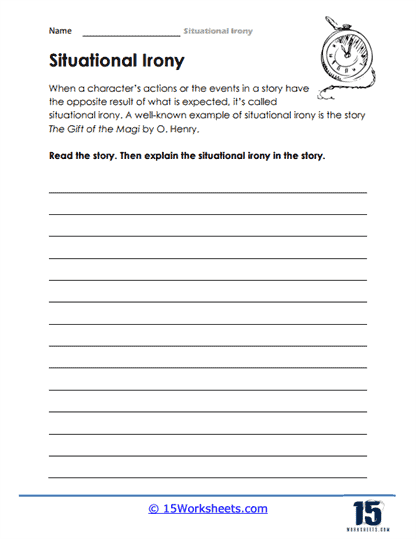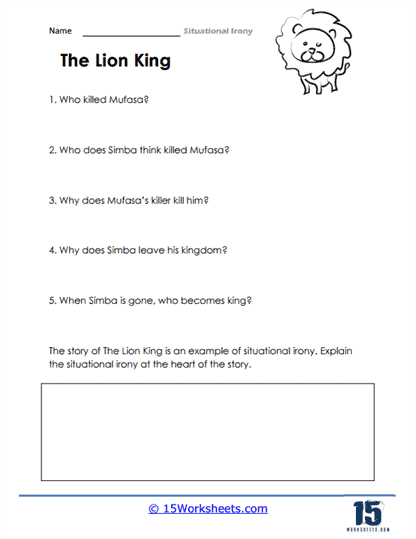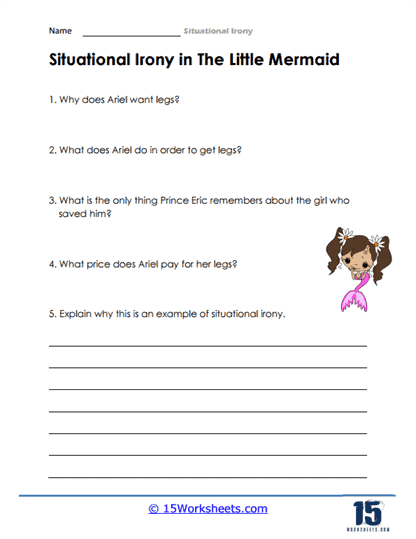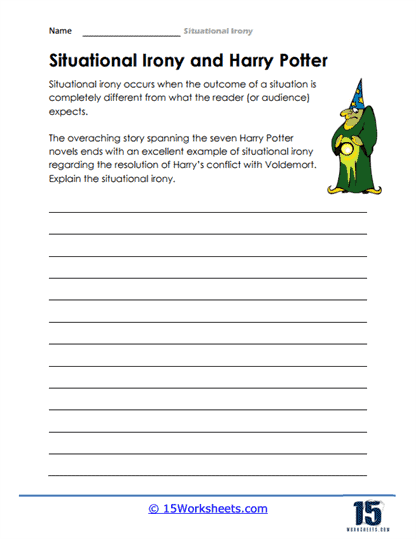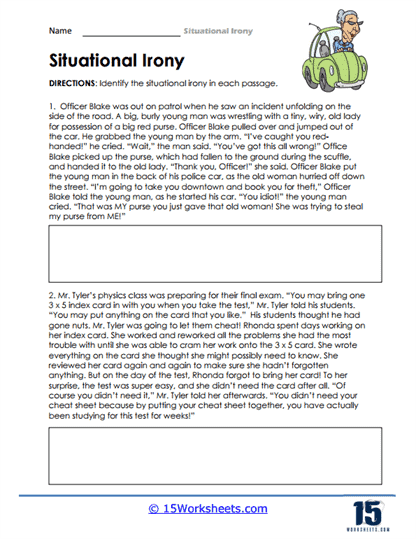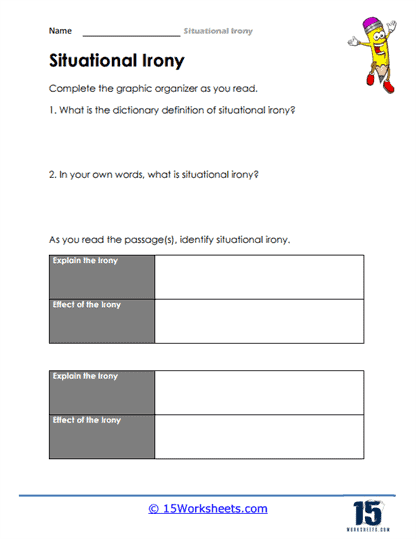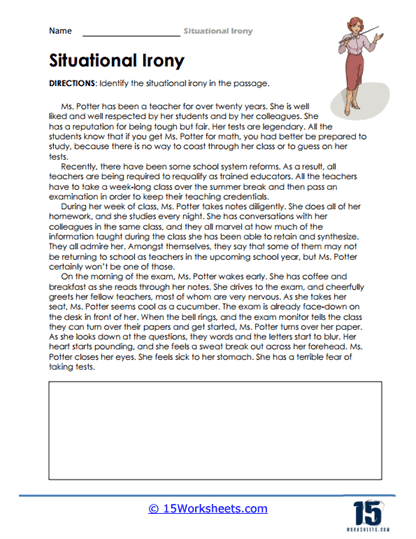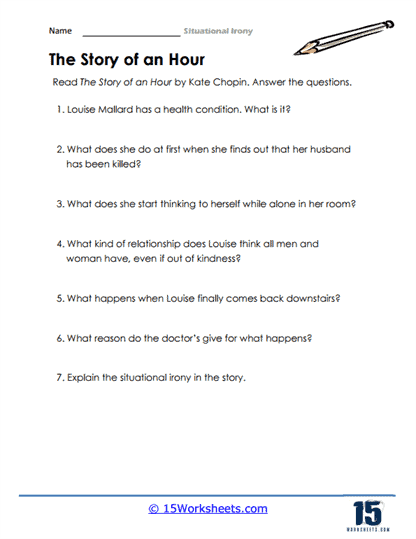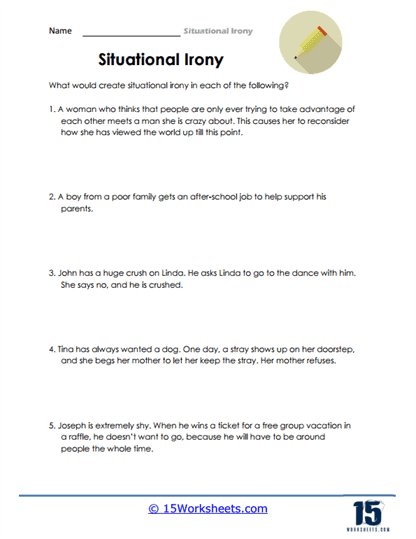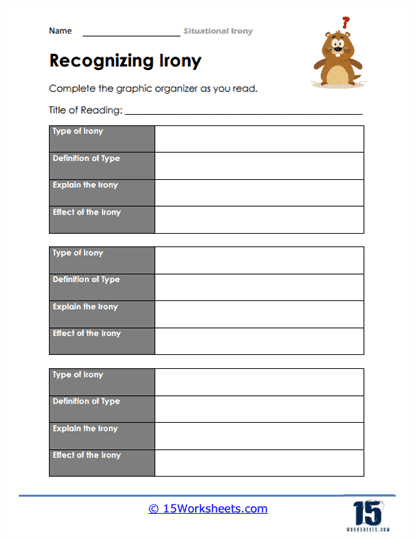Situational Irony Worksheets
All About These 15 Worksheets
Situational irony, the juxtaposition of unexpected outcomes and circumstances, is a literary device that adds depth and complexity to narratives. Understanding situational irony is not only important for literary analysis but also for developing critical thinking, comprehension, and a nuanced appreciation of storytelling. This collection of 15 worksheets is designed to introduce students to the world of situational irony, helping them grasp the importance of this literary technique, recognize its various forms, and develop their own analytical and creative skills.
What Are Situational Irony Worksheets?
Situational irony worksheets are exercises designed to help you understand and identify situational irony in texts. Situational irony is when the opposite of what is expected happens in a story or situation. It can add surprise, humor, or suspense to a narrative. For example, imagine you’re reading a story about a fire station that unexpectedly catches on fire. That would be situational irony because you’d normally expect a fire station to be the place putting out fires, not having one!
These are the types of exercises you will find on these worksheets:
Identification Exercises – These exercises will involve snippets of stories or sentences where situational irony occurs. The student is asked to identify and explain why it’s considered situational irony.
Story Analysis – A complete story or an excerpt from a novel may be provided with the task to find instances of situational irony. The student will have to explain how it adds to the narrative, whether it creates suspense, humor, or surprise.
Creative Writing – Some worksheets may ask students to write their own short story using situational irony. This helps in understanding the concept better as well as enhancing creative writing skills.
Multiple-Choice Questions – These might be included where a situation is provided, and the student has to choose the option that best demonstrates an ironic outcome.
Matching Exercises – This might involve matching sentences or stories with their ironic interpretations.
Why Do Authors Use Situational Irony As a Literary Device?
Situational irony is a literary device that you’ll find in many stories, books, and even in real life situations. It happens when the actual result of a situation is completely different from what you’d expect. In other words, it’s like life throwing a curveball at you. The main defining feature of situational irony is the surprise element that comes with the unexpected outcome.
This type of irony engages readers because it brings an element of surprise and unpredictability. It adds depth to the story and keeps readers on their toes. Furthermore, it often makes the story more memorable because of the unexpected twists and turns.
Examples of Situational Irony in Literature
“The Gift of the Magi” by O. Henry
One of the most famous examples of situational irony comes from this short story. In “The Gift of the Magi”, a young couple, Della and Jim, are very much in love but quite poor. For Christmas, each one wants to give a special gift to the other, but they can’t afford it. So, Della sells her beautiful hair to buy a chain for Jim’s cherished pocket watch, while Jim sells his watch to buy combs for Della’s hair. The irony is that each gift is now useless, and their actions subvert the expected outcome. It’s a clear illustration of situational irony, and it emphasizes the theme of selflessness and the value of love over material possessions.
“The Story of an Hour” by Kate Chopin
This short story provides a profound instance of situational irony. The protagonist, Mrs. Mallard, hears that her husband has died in a train accident. Given her weak heart, everyone fears that the shock may affect her health severely. However, she feels a sense of freedom and is quite relieved because her marriage wasn’t happy. She dreams about living her life for herself. But, when it turns out that her husband is alive and he appears in front of her, she dies from the shock of seeing him. In this case, the irony lies in the expectation that the news of her husband’s death would kill Mrs. Mallard, while in reality, his return was what caused her death.
“Romeo and Juliet” by William Shakespeare
In Shakespeare’s tragedy “Romeo and Juliet”, the young lovers’ deaths are an instance of situational irony. Romeo finds Juliet in a drugged state and believes her to be dead. Heartbroken, he drinks a poison to join her in death. However, Juliet was only sleeping using a potion, and she wakes up to find the dead Romeo by her side. Devastated, she stabs herself. The tragic irony lies in the fact that they both die, trying to escape a life without each other, not knowing the reality of the situation.
These instances underline the fact that situational irony can be used effectively to underline the theme, evoke an emotional response, or just add an element of surprise in a narrative. Whether the result is comic or tragic, the surprise twist that situational irony provides often leaves a lasting impression, making the story more intriguing and memorable for the reader. The unexpected nature of situational irony often mirrors life itself, making the literary work seem more realistic and relatable.
Benefits Of Situational Irony Worksheets To Students
Exploring the world of situational irony through this collection of 15 enlightening worksheets offers students an opportunity to develop essential skills in literary analysis, critical thinking, comprehension, creative writing, and narrative engagement. Situational irony is a literary device that invites students to question assumptions and explore unexpected plot developments.
By engaging with these exercises and activities, students not only enhance their academic abilities but also gain valuable tools for understanding and creating compelling narratives. The benefits of studying situational irony extend far beyond the classroom, empowering students to be more discerning readers, skilled writers, and active participants in the world of storytelling.

